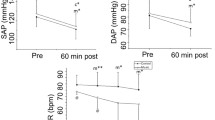Abstract
Music goes back a very long way in human experience. Music therapy is now used in many disparate areas—from coronary care units to rehabilitation after a stroke. But its widespread adoption has a poor scientific evidence base, founded more on enthusiasm than on proper evaluation in any controlled way. This has led to a lack of clarity about whether any particular type of music is superior, or whether different types of music should be tailored to differing individuals. We therefore conducted a series of controlled studies in which we examined the effects of different styles of music—from raga to jazz—presented in random order to normal young subjects (both musically trained or not). We found that contrary to many beliefs the effect of a style of music was similar in all subjects, whatever their individual music taste. We also found that this effect appeared to operate at a sub-conscious level through the autonomic nervous system. Furthermore, musical or verbal phrases of a 10 s duration (which coincided with the normal circulatory ‘Mayer’ waves) induced bigger excursions in blood pressure and heart rate (reciprocal of pulse interval) and so triggered more vagal slowing and feelings of calm. These findings need to now be tested in the clinical setting since, if confirmed, this would greatly simplify the practical use of this promising tool.
Similar content being viewed by others
References
Sleight P, La Rovere MT, Mortara A, et al. Physiology and pathophysiology of heart rate and blood pressure variability in humans: is power spectral analysis largely an index of baroreflex gain? Clin Sci. 1995;88:103–9.
Bernardi L, Sleight P, Bandinelli G, et al. Effect of rosary prayer and yoga mantras on autonomic cardiovascular rhythms: comparative study. BMJ. 2001;323:1446–9.
deBoer RW, Karemaker JM, Strackee J. Hemodynamic fluctuations and baroreflex sensitivity in humans: a beat-to-beat model. Am J Physiol. 1987;253:H680–9.
Bernardi L, Porta C, Sleight P. Cardiovascular, cerebrovascular, and respiratory changes induced by different types of music in musicians and non-musicians: the importance of silence. Heart. 2006;92:445–52.
Bernardi L, Porta C, Casucci G, et al. Dynamic Interactions Between Musical, Cardiovascular, and Cerebral Rhythms in Humans Circulation. 2009;119:3171–3180
Mockel M, Rocker L, Stork T, et al. Immediate physiological responses of healthy volunteers to different types of music: cardiovascular, hormonal and mental changes. Eur J Appl Physiol Occup Physiol. 1994;68:451–9.
Szmedra L, Bacharach DW. Effect of music on perceived exertion, plasma lactate, norepinephrine and cardiovascular hemodynamics during treadmill running. Int J Sports Med. 1998;19:32–7.
White JM. Effects of relaxing music on cardiac autonomic balance and anxiety after acute myocardial infarction. Am J Crit Care. 1999;8:220–30.
Lee D, Henderson A, Shum D. The effect of music on preprocedure anxiety in Hong Kong Chinese day patients. J Clin Nurs. 2004;13:297–303.
Author information
Authors and Affiliations
Corresponding author
Rights and permissions
About this article
Cite this article
Sleight, P. Cardiovascular effects of music by entraining cardiovascular autonomic rhythms music therapy update: tailored to each person, or does one size fit all?. Neth Heart J 21, 99–100 (2013). https://doi.org/10.1007/s12471-012-0359-6
Published:
Issue Date:
DOI: https://doi.org/10.1007/s12471-012-0359-6




